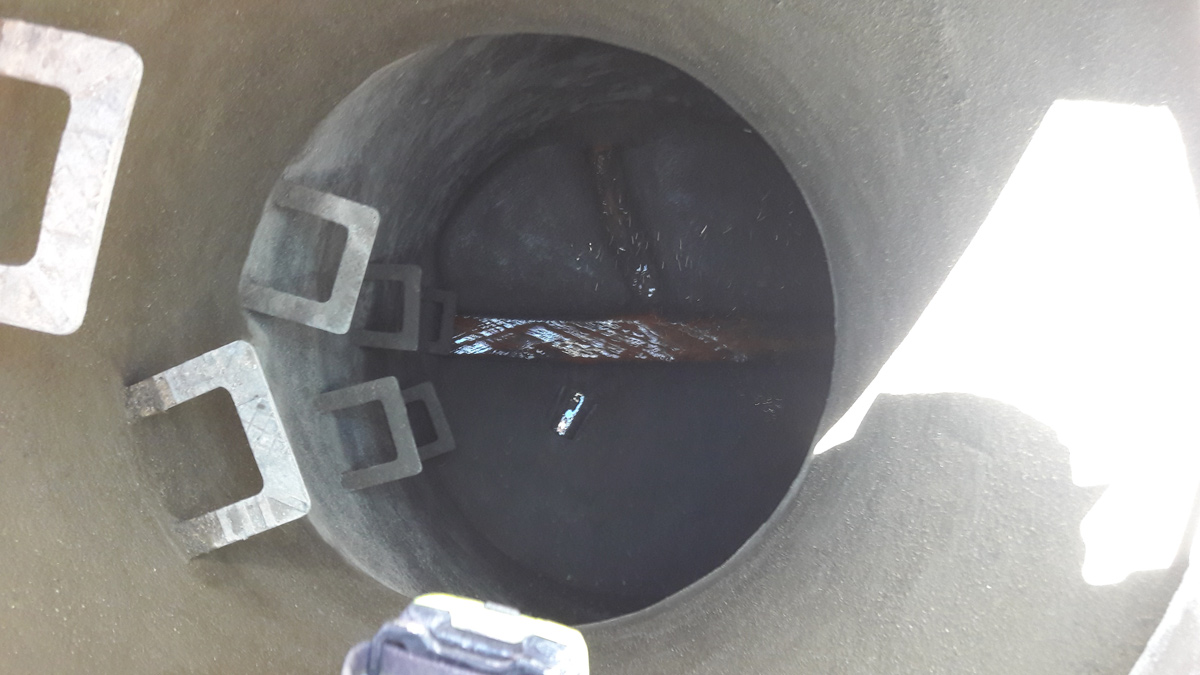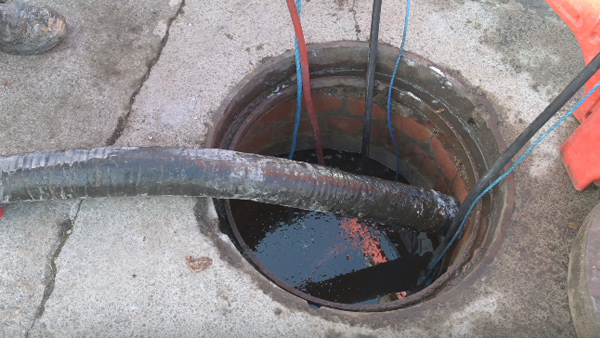Slimbridge Infiltration Reduction (2019)

Overview of Slimbridge - Courtesy of nmcn PLC
In 2013, two villages in Gloucestershire; Slimbridge and Cambridge, were identified by Severn Trent to be suffering from significant infiltration of groundwater. The Slimbridge and Cambridge catchment is home to approximately 1,136 people (2011 census) and contains an ecologically important wetland. Both villages have historically high groundwater levels and extensive CCTV footage of mainline, lateral sewers, private drains and manholes had identified several locations with visible infiltration.
Infiltration issues
Infiltration of groundwater into the sewer network is putting an increased demand on the UK’s sewer systems, resulting in increased operational and capital costs for the additional pumping and treatment of groundwater. Coupled with this, the hydraulic capacity of the system can be exceeded, leading to surcharging of the sewer system and an increased likelihood of internal and external flooding incidents. Issues associated with infiltration are often exacerbated by high groundwater levels, which often occur near watercourses and in wetlands.
Slimbridge was ranked 21st in Severn Trent’s overall sewer flood risk database (top 1%) tables and had repeated issues of internal flooding and surcharged pumping stations; this coupled with significant pressure from the Parish council and local MPs resulted in an infiltration reduction scheme being established.
To address the flooding concerns, an initial proposal was made to increase the pump rates at the Ryalls Lane Sewage Pumping Station and to upsize the rising main to the sewage treatment works located in nearby Coaley. This initial option was rejected based upon high energy requirements, high operational costs and the additional pressure this would put on the Coaley STW.
An alternative solution was proposed for sealing the network, with the aim of reducing infiltration by a target of 75%, resolving one internal, five highway and twelve external flooding drivers. It was also recognised that the hydraulic capacity of the highway drainage system was inadequate. Working in partnership with Gloucestershire CC, twelve properties benefitted from highway drainage improvement and surface water separation works.
Scope determination: CIPP lining vs flood grouting
Galliford Try was the design and build contractor for the scheme. Initial feasibility work was undertaken including extensive CCTV and mapping of the existing network to identify connectivity and points of infiltration. Slimbridge presented a significant challenge as there was a need to seal pipe joints fully which, if done by traditional open trench repair techniques, could cause major disruption to customers. A scope of approximately 1.4km was identified for rehabilitation works.
CIPP lining has been the most commonly used method of reducing infiltration and rehabilitating a pipe network. However, research by the Water Research Council (WRc) has suggested that:
“… not all cured in place (CIPP) linings reduce infiltration, as certain lining materials can shrink during and/or after installation (e.g. loss of solvents during curing or thermal shrinkage after curing). This results in an annulus between the lining and host pipe through which infiltration has passed and hence enter the sewer system at locations such as manholes or lateral connections.”
WRc lining testing was undertaken between 2006-2008 which identified several liners which passed infiltration testing, CP308. Galliford Try approached Onsite Ltd, who confirmed they were able to install SealLiner type liners through CIPP; adhering to best practice as specified in CP308 testing.
To ensure complete sealing of the network the CIPP lining works were undertaken in conjunction with manhole spray lining and resin injection. This involves accessing the manhole chambers, and drilling multiple holes into the wall of the manhole chamber where a polyurethane-based injection foam is applied. Once this operation has been completed a secondary flexible polyurethane injection is applied to the inside walls. This seals the manhole from exfiltration and infiltration.
A review of alternative techniques to lining was undertaken including revisiting flood grouting, a trenchless rehabilitation technique that had been introduced to the UK in the early nineties by Sanipor®. Over time, CIPP lining techniques were favoured more commonly than grouting techniques. Flood grouting involves the two-part pouring of silicate solutions to form a soil-grout- matrix around the pipe to prevent infiltration and exfiltration. The proposed sewer section is isolated into manageable sections by installing stoppers and braces.

Example of manhole sealing works – Courtesy of Galliford Try
These sections typically consisted of isolated sections with two or three laterals (100-150mm diameter), up to four manholes (approximately 900-1200mm) and one or more associated main pipe run (150mm).
First the system is cleaned via jetting, a CCTV inspection is then carried out to assess the structural condition of the pipe and to understand lateral positions on each section. Once this is done, hydro-testing can be carried out to quantify the leakage rate of the section to be treated. Once all tests and inspections have a satisfactory outcome, flood grouting can begin. With the stoppers and braces securely in place, the isolated sewer segment is flooded with the first component called S1 up to manhole cover level.
The hydrostatic pressure ensures the liquid is injected through any cracks or gaps in the sewer and manholes, and saturates the surrounding sub-soil. Due to the higher density and viscosity of S1 it can be applied against groundwater pressure, forcing its way past any infiltration. S1 is then pumped out of the sewer, leaving the surrounding subsoil saturated. The section is then flushed and subsequently flooded with the S2 component. When mixed, the S1 and S2 react with the soil particles to form the soil-grout-matrix.
The end product is a sandstone like mix of the two components which achieve up to 99% water tightness to satisfy EN1066. The relative quantities of materials can be approximately calculated by understanding the relative volumes of each pipe and manhole. The S1 and S2 components are recycled throughout the process and depending on the drop rates of the S1 or S2 the process can be repeated until saturation with the sub-soil is achieved. Due to this, ordering of a higher amount of material than needed is almost unavoidable.
Benefits and limitations of flood grouting
The benefits of flood grouting over the traditional lining are that the method is able to maintain the full pipe capacity, as well as resolving any infiltration in the manholes and laterals of the pipe in question. The sealing effect is created by a watertight soil barrier created around any leak in the sewer system. Migrating groundwater creates channels towards the leaking pipes and manholes and over time it is these lines of least resistance that are blocked by the Sanipor® solution. The grouted soil envelope is protecting the drainage system against pressing groundwater, soil erosion and supports all pipes and manholes structurally from the outside, extending the assets lifespan.
Whilst the flood grouting technique offers many benefits, it was advantageous to use in conjunction with traditional infiltration lining and manhole spraying techniques.
The benefit of the Sanipor® technique is large sections of the system including the manholes and laterals can be sealed in one pour. This reduces the installation time and potential material cost. The grouting technique also improves the bedding around the sewer pipes.
It is however unsuitable for sewers with structural defects such as large holes, large fractures and breaks. It is also unsuitable for use if the pipe bedding is missing or is porous. Additionally, the grouting technique does not provide structural integrity to the pipe unlike sewer lining methods. The grouting technique also relies on ambient curing and therefore the curing time can be affected by seasonality.

Manhole flooded with solution – Courtesy of Galliford Try
A review of the scoped work identified several sewer pipes with structural defects of grade 4 or 5. It was decided that structural lining would be the most suitable solution for these lengths, whereas lengths which had lower structural scores and had an increased number of manholes or laterals were more suitable for the flood grouting techniques. Following the above technical consideration, additional commercial, practical and customer aspects of procuring and undertaking, a total of 1.4km of sewer pipe identified for rehabilitation works, 800m was selected for traditional lining and manhole sealing techniques, whilst the remaining 600m was selected for the flood grouting trial.
The flood grouting works required two tankers for the S1 Solution, S2 Solution and a Jet Vac unit for pre and post-cleansing and a CCTV unit was also required for confirmation on position of laterals and pre condition surveys. In comparison, the sewer lining works required the CCTV unit, Jet Vac unit and the liner rig only.
A majority of the grouting and lining works were undertaken in private driveways and gardens throughout Slimbridge. Whilst both techniques used minimised disruption to residents (when compared to open trench replacement techniques) the number of operatives required for flood grouting works was higher than a typical sewer lining set up would require.
Post review of techniques
Both the CIPP lining works and flood grouting works were CCTV surveyed to confirm no visible infiltration and that CIPP lining had been installed correctly (i.e. no defects or wrinkling in liner). The initial results indicated the scheme has been successful with a no visible infiltration on any of the post-CCTV surveys when compared to the pre-surveys. To further demonstrate the effectiveness of the overall project, pumping station monitoring equipment was installed at the Ryalls Lane SPS (flow meter and groundwater measuring in a permeant borehole) in the catchment to allow the pumping rates to be compared pre and post-project. The results of this longer-term study are not yet known however, an initial review of the flow meter telemetry information indicates virtually no response to rainfall and diurnal wet well profile still being maintained despite increasing catchment wetness. This diurnal pattern was not visible pre-construction phase and hence suggests one or more of the construction techniques have significantly decreased flows to Ryalls Lane SPS.
Slimbridge Infiltration Reduction: Key Participants
- Client: Severn Trent
- Principal contractor: Galliford Try
- Principle subcontractor: Onsite
- Subcontractor: Sanipor
Upon completion of the flood grouting works, each section is tested for water-tightness by repeating the hydrostatic test carried out prior to the work commencing, this provides back to back results demonstrating the effectiveness of the operation.
On a project level review, the outputs were claimed in year four of AMP6 (FY19) as required by the client, on time and in budget. The successful work in collaboration with Gloucestershire County Council also led to the endorsement of a partnership measure by the Environment Agency. Resulting in an AMP6 Outcome Delivery Incentive benefit to Severn Trent.

Vehicle set up flood grouting works – Courtesy of Galliford Try
Conclusion
The flood grouting provided a significant saving against the initial Severn Trent target price for the scheme. The true cost benefit of flood grouting comes from treating not only the main pipe, but also the associated laterals and manholes of each section. In deciding on what the most appropriate technique is for each run, it is important to understand firstly how many laterals and manholes are being treated.
For sections with fewer manholes and laterals or with significant structural defects, CIPP lining techniques are more favourable as they are more cost effective, offer structural stability to the pipe and required a reduced operative presence on site in comparison to grouting works. Where larger sections of sewers with multiple laterals and manholes are present the flood grouting technique would offer a saving in both time and material cost.



